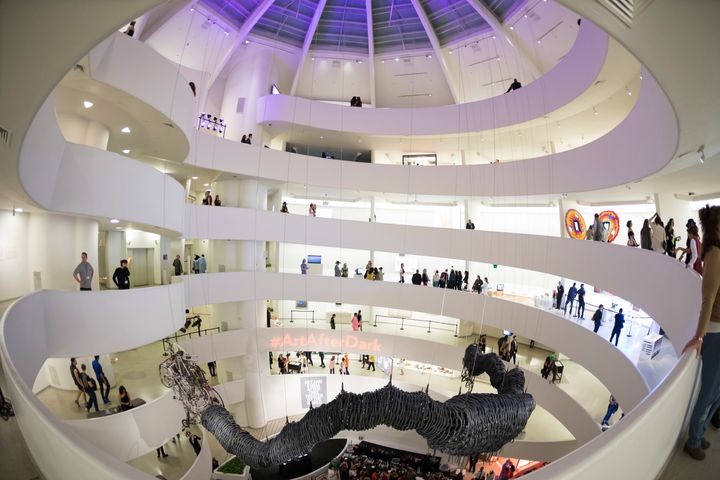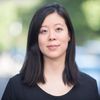
Art After Dark: Halloween October 27, 2017 Photo: Ben Hider © Solomon R. Guggenheim Foundation
The night of the Guggenheim Museum’s Art After Dark: Halloween event coincides with the ninth day of the ninth month of the lunar calendar in Asia, the day of the Double Ninth or Chongyang (重阳) Festival, which has been celebrated as early as the Eastern Han period (25-220 AD). The superstition is that it is dangerous due to an excess of yang or masculine heated energy. Ancient myths describe families who were able to escape demons by going to higher ground, which has led to the modern tradition of climbing mountains to honor one’s ancestors.
It is on this night that I ascend the spiral white rotunda of the Guggenheim Museum to view “Art and China after 1989: Theater of the World,” which features the works of 71 artists, including Ai Weiwei and Paris-based artist Huang Yong Ping. The exhibition bristles with yang energy— fiery and mordant. It begins with documentation of a pivotal moment.
On February 5, 1989, a young woman artist Xiao Lu walked into the National Art Museum in Beijing and fired two shots from a pellet gun into the centerpiece glass mirror of her installation “Dialogue” (two telephone booths and a red telephone with an unhooked receiver in between). Her work was on display as part of a government-sponsored exhibition China Avant-Garde. The act led to the closure of the exhibition and the subsequent withdrawal of official support for performance art. A few months later, martial law was declared on May 19, 1989, and Western coverage of the events that led up to June Fourth Tiananmen Incident became significantly limited.
For many of the viewers of the exhibition on this particular night, which draws a largely millennial crowd, the events of 1989 happened before they were even born. But even for those who were alive and old enough to watch the news, this period is shrouded in darkness.
Two concepts are helpful as lens through which one can understand the invaluable nature of this exhibition: Heisenberg’s principle of uncertainty and the palimpsest form.
In 1925, physicist Werner Heisenberg described what would later become known as the uncertainty principle in quantum mechanics:
It can be expressed in its simplest form as follows: One can never know with perfect accuracy both of those two important factors which determine the movement of one of the smallest particles—its position and its velocity. It is impossible to determine accurately both the position and the direction and speed of a particle at the same instant.
Particles exist in a “haze of probability.” Physicists have tried to circumvent this limitation, and one such method is called “compressive sensing,” a technique used in digital photography and MRI scans. Compressive sensing aims “to accurately recover a high-dimensional signal from a small set of measurements,” and allows one to compress a signal while measuring it, like capturing images as jpegs rather than large raw files and compressing them later.
Similarly, the works of these 71 artists act as precious signals— a sort of compressed sensing— that elucidate an uncertain period elusive to direct measurement. The works offer a rare glimpse into the questions of and responses to issues of expression, identity, globalization, and experimentation in contemporary China after 1989. There are deep-fried toy tanks, live feedback video footage nested in colorful funeral floral wreaths, a six-channel video installation of frantic human bodies, and a “suspended funeral” of hanging industrial junk and Buddhas statues.
Notably, three pieces could not be shown, due to safety concerns and amidst public protest: a Hobbesian cage by Huang Yong Ping that would have contained live insects and reptiles (the list reads: “African millipedes, goliath beetles, hissing cockroaches, house crickets, lubber grasshoppers, and stag beetles, leopard geckos, and Italian wall lizards”), a 1994 video documentary of “A Case Study of Transference” of copulating pigs stamped in ink with Roman letters and invented Chinese characters, and a 2003 recorded performance of Sun Yuan and Peng Yu, “Dogs That Cannot Touch Each Other,” which placed harnessed pit bulls across from each other, running towards each other on treadmills.
In many ways, the nearly 150 pieces act individually and collectively as palimpsests, multi-layered texts on which the original text has been partially erased and then overwritten by others. Palimpsests come in many forms (the “true” or strictest form is one in which traces of the original text is gone). Archeologist Geoff Bailey describes the cumulative form here:
A cumulative palimpsest is one in which successive episodes of deposition, or layers of activity, remain superimposed one upon the other without loss of evidence, but are so reworked and mixed together that it is difficult or impossible to separate them out into their original constituents... and may acquire a significance that is greater than the sum of the individual constituent[s].
Geng Jianyi in “Forms and Registration” (1988) parodies government registration forms used to obtain information from artists prior to official exhibitions. In “Wu Street” (1993-94), Xu Bing and Ai Weiwei repurpose found abstract paintings from street trash, present them as important works of art by a fictitious painter, and manage to get a faux review published in an esteemed Chinese art magazine. In “Stamping the Water” (1996), Song Dong repeatedly stamps the surface of the Lhasa River with a wooden block carved with the character for water (水), making invisible marks. Qiu Zhijie in “Orchid Pavilion Preface” (1990-95) copies text repeatedly over a hundred sittings on the same paper until the meaning of the text is lost to abstraction.
These artists all seem to demonstrate an excess of yang energy— and for good reason. Faced with a shared history that has at times been at risk of being completely effaced, these artists work tirelessly to superimpose, rework, restore, or reshape the text of their past in an effort to understand their present and grapple with their future. As one ascends each level of the rotunda, their cumulative palimpsest emerges and offers us insights far greater than the sum of the individual parts.
